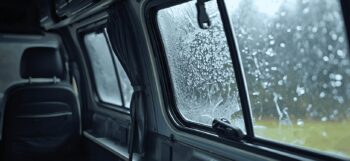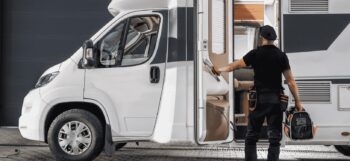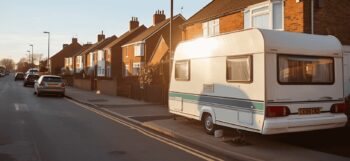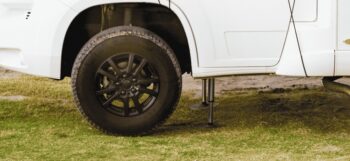Embarking on a caravan adventure brings unparalleled freedom, but the challenges of navigating high winds demand careful consideration.
In this guide, we'll delve into crucial aspects of caravan safety in windy conditions, towing practices, and how to pitch up for an enjoyable and safe journey. Continue reading to learn more about the following:
- Towing legally
- The challenges of high winds
- Types of stabiliser
- Weight distribution for towing stability
- Real-time weather monitoring
- Pitching and stability in high winds
- Awnings and high winds
- Insurance
Towing legally
First thing’s first, towing legally in the United Kingdom demands adherence to specific regulations to guarantee both road safety and compliance with the law. In the UK, drivers must possess the appropriate driving license entitlement to tow a caravan, and the entitlements vary based on when the license was acquired.
If you obtained your driving license before January 1, 1997, you are generally allowed to tow trailers with a MAM of up to 8,250 kg. This includes most caravans. However, it's always advisable to check your specific entitlements on your driving license.
If you obtained your driving license after January 1, 1997, the rules are more specific. You can tow a trailer with a MAM of up to 750 kg, or a trailer with a MAM exceeding 750 kg if the combined MAM of the towing vehicle and trailer is not more than 3,500 kg. If you want to tow a trailer with a MAM exceeding 750 kg and the combined MAM is more than 3,500 kg, you need to pass an additional test to get the B+E entitlement on your license.
Ensuring that the towing vehicle and caravan combination adheres to the legal weight limits is imperative, and this includes the Maximum Authorised Mass (MAM) and Gross Train Weight (GTW).
If you’re unsure how to calculate this, Towsafe outfit matching can match your car to your caravan, to help you stay safe and legal. It’s also advisable to choose the right towbar for your vehicle.
Regular maintenance checks of your towing equipment, including trailer brakes and lights, are mandatory to uphold safety standards. Moreover, you should also be aware of specific speed limits when towing, as exceeding these limits could result in penalties. Staying informed about the latest towing regulations and practicing responsible towing not only guarantees legal compliance but also contributes to safer journeys on UK roads.

The challenges of high winds
Towing safety in windy conditions
Navigating high winds while towing a touring caravan requires a strategic approach.
Understanding the interplay between your caravan's dimensions and wind resistance is vital to maintaining stability. Sudden gusts can lead to swaying or snaking, emphasising the need for a controlled and steady driving pace.
Stick to back roads
Attempting to travel on the motorway with a caravan becomes impractical when driving at slower speeds. Consequently, it is advisable to steer clear of motorways whenever feasible, to avoid getting caught up in the surge of fast-moving traffic. Motorways, due to their straight paths through open terrain, are more susceptible to strong winds. In contrast to smaller roads that meander through towns, motorways expose caravans to increased risk.
If travelling on a motorway is your only option, you should be cautious about the abrupt changes in wind speed caused by larger vehicles, such as lorries, when overtaking them. This buffeting effect can lead to significant issues, often causing caravans to veer off course.
Consider a stabiliser!
When towing a touring caravan, there are two types of undesired movement you may experience.

Constantly correcting sway (yaw) and maintaining control or your vehicle and caravan in high winds can be tiring. Experiencing either type of movement can also induce panic and could lead to potential accidents.
Stabilisers are designed to reduce swaying or snaking; particularly important when driving at high speeds or when facing crosswinds, as they enhance overall stability and control. It's important to note that while stabilisers enhance stability, they do not replace the need for proper loading of the caravan or trailer and adherence to safe towing practices.
Types of stabiliser
Blade stabiliser: This system uses a metal leaf spring and a friction turntable at the back of the car to connect your car's towing bracket to your caravan's drawbar. If the caravan moves sideways, the turntable's friction pads resist the movement. The strong metal spring also resists up-and-down movements, reducing pitching.
Typically, the installation of this stabiliser type is most suitable for conventional fixed flange towbars. However, in some cases, a clamp can be affixed to a swan-neck towbar. This article from Trailer Trek Towbars explains more about towbar types.
Tow ball-mounted stabiliser: Also known as a sway control or stabiliser bar, this is used in towing setups to enhance stability and control when pulling trailers, caravans, or other towed loads. This type of stabiliser is typically attached to the tow ball on the towing vehicle and is designed to minimise the swaying or oscillation of the towed load.
One end of the stabiliser is connected to the tow ball on the rear of the towing vehicle. The other end is linked to the frame or drawbar of the caravan. As the towing vehicle and the caravan move, especially during lateral movements or swaying, the stabiliser provides resistance to these motions.
Tow ball-mounted stabilisers are particularly useful in situations where factors like crosswinds, passing vehicles, or uneven road surfaces may induce swaying in the towed load.
Active Trailer Control (ATC): While towing, experiencing some natural movement in the caravan is normal. However, when your car/caravan weight ratio is appropriate, your caravan is loaded correctly, and your outfit is being driven in a proper manner, any side-to-side swaying should naturally subside.
The ATC system consistently observes the caravan's sway, and if it identifies an increase in sideways movements instead of a decrease, it briefly activates the trailer brakes to realign the caravan. However, ATC won’t respond to sudden movements that self-correct or occur during normal cornering.
Weight distribution for towing stability
Proper weight distribution is paramount when it comes to ensuring towing stability and plays a crucial role in the on-road performance of your caravan. Complying with the recommended weight limits specified by the manufacturer is imperative to prevent issues such as swaying, fishtailing, or even loss of control during transit.

To ensure optimal weight distribution, start by placing heavier items low and towards the middle of your caravan. This simple practice lowers the caravan's centre of gravity, enhancing its stability on the road. Additionally, make use of the caravan's designated storage areas, distributing weight evenly from side to side. Regularly check and adjust the distribution as needed, especially after loading or unloading items. A well-balanced load not only contributes to safer towing but also ensures a smoother and more controlled journey, allowing you to navigate the roads with confidence and peace of mind.
Real-time weather monitoring
The weather, particularly in the UK, is often unpredictable and conditions can change very quickly. Staying ahead of these changes is advisable for safe and enjoyable towing journeys.
Utilise weather apps such as BBC Weather or Met Office Weather or seek updates from local authorities to receive timely information on wind speeds, storm alerts, and any adverse conditions that could potentially affect your journey.
Armed with prior knowledge, you can make informed decisions on whether to adjust your route to avoid high-wind areas or delay your journey until conditions improve. This proactive approach not only ensures your safety on the road but also enhances the overall planning and adaptability of your caravan adventure.
Pitching and stability in high winds
High winds not only affect towing but can also present significant challenges during the setup of your caravan.

When pitching your caravan, it's not just about finding the most level spot; it's about strategically positioning your caravan to mitigate the impact of gusts and enhance its overall stability. Improper pitching in windy conditions can lead to swaying and an unstable living environment inside the caravan, which can feel unpleasant.
To counter these challenges, consider the following:
Wind direction: Before setting up, assess the wind direction. Position the nose (front) of your caravan facing into the wind to reduce wind resistance and enhance stability. This simple adjustment can make a substantial difference in how your caravan responds to gusts.
Stabiliser utilisation: As previously mentioned, stabilisers play a crucial role in preventing swaying and maintaining balance during high winds. Deploy them effectively to secure your caravan and create a more stable foundation.
Secure anchoring: Use additional anchoring methods to secure your caravan to the ground. This may include using sturdy pegs for awnings and windbreaks. A securely anchored caravan is less susceptible to the disruptive forces of strong winds.
Seek natural windbreaks: Where possible, seek out spots with natural windbreaks such as trees, hills, or structures. These features shield your caravan, minimising the impact of strong winds. This may not be possible when pre-booking a pitch, but you can ask to be moved if the campsite you’re staying on isn’t too busy.
Review campsite regulations for windy weather conditions: Research campsite regulations related to adverse weather. Some sites may have guidelines in place to prioritise the safety of caravan owners during high winds.
Caravan adventures are synonymous with freedom, but safety should always be a priority. With these considerations in mind, you can embark on a caravan journey, knowing the challenges high winds can present.

Awnings and high winds
Caravan awnings are a valuable addition to any caravan setup, providing additional living space and shelter. However, when facing high winds, it's crucial to exercise caution and take preventive measures to safeguard not only your caravan, but your awning too.
Selecting a high-quality, sturdy awning designed to withstand windy conditions is the first step. Proper installation and secure anchoring using robust pegs and guy ropes are imperative. Additionally, regularly check weather forecasts and be proactive in retracting or taking down your awning if strong winds are predicted. Periods of severe weather, such as storms or high winds, increase the risk of awning damage or in the worst-case scenario, your awning being ripped off, causing damage to your caravan. It's equally important to review your insurance policy to ensure it provides coverage against awning damage and damage to contents within.
One more thing…
Insurance
Ensuring you have insurance and breakdown cover for your vehicle can prove essential for safeguarding against unforeseen challenges on the road.
Insurance provides financial protection in the event of accidents, theft, or damage, offering peace of mind and avoiding significant out-of-pocket expenses. Additionally, caravan breakdown cover, acts as a safety net for mechanical failures or unexpected issues during your journey. Whether it's a flat tyre or an electrical failure, breakdown cover ensures prompt assistance and towing if necessary. Together, insurance and breakdown cover create a comprehensive safety net, allowing you to navigate the roads with confidence. Knowing that you are well-prepared for the unexpected and can quickly get back on track in case of any mishaps.
Find out more about our Touring Caravan insurance and RAC Touring Caravan breakdown cover*, and protect your adventures today!
Wishing you safe travels.
Policy limits and exclusions may apply, please see the policy wording for full terms and conditions.
*RAC touring caravan cover is not a standalone product and can only be purchased in conjunction with touring caravan insurance.
Disclaimer: The sole purpose of this article is to provide guidance on the issues covered. This article is not intended to give legal advice, and, accordingly, it should not be relied upon. It should not be regarded as a comprehensive statement of the law and/or market practice in this area. We make no claims as to the completeness or accuracy of the information contained herein or in the links which were live at the date of publication. You should not act upon (or should refrain from acting upon) information in this publication without first seeking specific legal and/or specialist advice. Arthur J. Gallagher Insurance Brokers Limited trading as Lifesure accepts no liability for any inaccuracy, omission or mistake in this publication, nor will we be responsible for any loss which may be suffered as a result of any person relying on the information contained herein.
FP1927-2025











